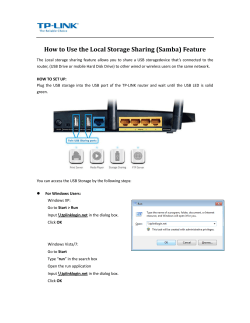
USB 3.0 Write Blocker Team Dec 1108 Design review presentation Team member
USB 3.0 Write Blocker
Team Dec 1108
Design review presentation
Team member
Client Info
Advisor
Chen Zhao
Electronic Crime Institution at Des Moines Area Community
College
Dr. Zhao Zhang
Elphas Sang
Joe Lane
jrlane@dmacc.edu
Yan Fang
Project Plan and High Level
Description
Problem Statement
• USB 3.0 to SATA data adapter
• Correct design of a command filter that drops
writing commands
Conceptual Sketch
Use case scenario
Conceptual Sketch (cont’d.)
Massive Storage Device on USB is complex in firmware organization. They
support both USB protocols required for universal USB devices and SCSI
standard between computer and peripheral devices.
An embedded system that function as a USB massive storage device has the
following list of requirements.
• A smart microcontroller that manages the system operations
• A USB device controller, which is another microcontroller that interfaces
to the USB port. This controller can also be integrated with the device’s
own CPU into one microcontroller
• A generic harddrive (flash drive) interfacing to the device’s CPU
• The device effectively responds to generic USB requests on the bus
• The device effectively responds to SCSI commands received in USB
transfers. These commands are industry standards for storage media.
Conceptual Sketch (cont’d.)
About embedded hosts
An embedded system working as a USB host for a hard drive or flash drive is
expected to perform the following functions.
1. Issue USB requests and initiate other events on the bus to identify attached
devices and manage traffic and power on the bus
2. Issue USB mass-storage requests that ask for status info or specify actions for the
device to perform
3. Issue SCSI commands in USB transfers. The commands read and write blocks of
data in the storage media, request status info and control the device operation
Functional Requirements
• Data Bridge between USB 3.0 and SATA
• This device acts as bridge for dataflow. It processes data transfer and
controls data package.
• Lossless Data Transfer
• Data transfer does not allow any information loss. The data transfer
should not be affected by the blocker except that no writing operation to
hard drive is allowed.
• Efficiency and latency issue
• Although efficiency depends on specific microcontroller hardware,
firmware also plays a great role on the quality and usability of the product.
A bad program may lag the hardware efficiency it should have
Non-Functional requirements
•
•
•
•
•
•
•
•
•
•
Product Quality (Reliability)
The ability of a system or component to perform its required functions under
stated conditions for a specified period of time.
Portability
The ability for the device to be moved from point A to point B. The device may
easily be used on different computers and for different hard drives.
Maintainability
The product is maintainable which means the hardware configuration is well
documented and may be updated and improved for later on projects.
Testability
Tests are easily performed on the device. And these tests demonstrate the
capability of the final product.
Usability
Ease-of-use requirements address the factors that constitute the capacity of the
software to be understood, learned, and used by its intended users.
Technical consideration
• Choice of device microcontroller
Some typical controllers with support for ATA/ATAPI:
Texas Instruments TUSB6250 USB 2.0 to ATA/TAPI bridge controller
Philips Semiconductor ISP 1583 Hi-Speed Universal Serial Bus peripheral controller
SMSC SW6313 Single Chip USB 3.0 to SATA Bridge
• Software Development Kits (SDK) for firmware update
need extra technical support from the microcontroller manufacturer
for example, Symwave also provides a variety of host application Software
Development Kits (SDK) for firmware update, Security password and Mass Production Tools
Market survey
• What makes our project unique?
Very few similar product exists around the market for USB 3.0
• There are quite a few products for USB 2.0 with similar
functions around the market nowadays. For example, Taleau
provides solutions for USB 2.0 to SATA bridge. ForensicPC has
a series of Forensic write-block products.
• But there is still no USB 3.0 blocker product in the market. In
2009, Fujitsu Microelectronics shipped its first generation of
USB 3.0-Serial SATA bridge IC. MB86C30A incorporates USB
and SATA signal communication control circuits, protocol and
command control circuits with a high-speed
encryption/decryption engine on a single device.
Potential risks
• Schedule Risks
Development Board Choice is the first step of the project and
is the crucial step. A rational choice should be made
considering the difficulty level of implementation and
reliability of the final product.
• Technical Risks
The hardware configuration consists of module
implementation and integration. This is a complex procedure
and it takes a long time to put a module into work.
• Operational Risks
Improper operation on the device (especially during the
testing process) may cause irreversible hardware damage.
Cost Estimate
USB3.0 to Sata Bridge Chip
About $30
Development Kit For the Chip
About $100
Programming Board and Tools
to be announced
Other Resources
About $70
Total Cost
About $200
Total Budget
$2000
Project Milestones & Schedule
System Detailed Design
• Hardware platform
• Firmware program
Functional Decomposition
1. USB 3.0 to SATA adapter
2. Support for Mass-Storage Devices Compatible
With the ATA/ATAPI-8 Specification
3. UASP protocol compliant mass storage device
suitable for bridging hard disk drives (HDD)
4. Auto-load firmware (boot code and program
we write)
System architecture
• Take the ARM cortex M3 microcontroller based USB
3.0 to SATA bridge board as an example.
• It provides various necessary firmware to implement
bridging for hard drives, solid disk drives, optical
drives and other SATA 3.0G standard drives. What we
study is the connection between the host (USB 3.0
PC) and massive storage device, in super speed
transfer mode.
ARM cortex M3 microcontroller structural diagram
Another USB 3.0 microcontroller
SW6313 Single Chip USB 3.0 to SATA Bridge
a product from Symwave (now part of SMSC)
Technical Support
• Symwave also provides a variety of host application
Software Development Kits (SDK) for firmware
update, Security password and Mass Production
Tools - everything necessary for rapidly moving
through development and into production.
• Ordering Information Design materials (schematics,
layout, data sheet) are available upon request.
Firmware Program
• Principles on how the program works
an example of a writing command block format
bit 7
bit 6
bit 5
bit 4
bit 3
bit 2
WRITE(10)
byte 0
Operation code
OP=2A
byte 1
logical unit number
reserved
byte 2
byte 3
byte 4
logical block address
byte 5
byte 6
byte 7
byte 8
reserved
Transfer length (MSB 7, MSB 8)
byte 9
reserved
byte 10
reserved
byte 11
reserved
bit 1
bit 0
Some other SCSI command blocks
Code
Command
00
TEST UNIT READY (mandatory)
01
RECALIBRATE or REWIND
03
REQUEST SENSE (mandatory except RBC)
04
FORMAT UNIT
05
READ BLOCK LIMITS
07
REASSIGN BLOCKS
07
INITIALIZE ELEMENT STATUS
08
READ (6)
0A
WRITE (6)
0B
SEEK (6)
28
READ (10)
29
READ GENERATION
2A
WRITE (10)
An example routine
•
•
void MSDWriteHandler()
{
•
•
•
•
•
byte *adr;
byte flag;
word i;
dword sectorNum;
WORD TransferLength;
•
•
•
•
•
•
•
•
•
•
•
•
•
LBA.v[3]=gblCBW.CBWCB[2];
LBA.v[2]=gblCBW.CBWCB[3];
LBA.v[1]=gblCBW.CBWCB[4];
LBA.v[0]=gblCBW.CBWCB[5];
•
•
TransferLength.v[1]=gblCBW.CBWCB[7];
TransferLength.v[0]=gblCBW.CBWCB[8];
•
•
•
•
•
while(TransferLength._word>0)
{
•
/*
•
* Read data received from teh USB host and write the contents to the media •
*/
•
•
...
•
•
•
•
•
•
•
•
while(msd_csw.dcswDataResidue>0)
{
MSDDataOut();
}
//check status, if or not successful
if(status)
{
//The sector write failed
msd_csw.bCSWStatus=0x01;
...
}
•
•
•
•
•
•
LBA._dword++; TransferLength._word--;
if(TransferLength._word>0)
{
/*
check if more data to receive
*/
...
}
else
{
//all data received
...
}
•
•
}
return;
•
}
Testing plan
• Simulation:
• Writing code that will disable writing
commands. We can do this process
either in two ways:
Simulating a writing error checking on the
board
Using the host to return valid parameter bits.
Testing
Test
Description
Unit testing:
•
•
•
•
Hardware blocking commands
Return request of read operations
No modification of requested information
Error checking
Integration testing:
•
Develop a prototype of USB 3.0 that is integrated from USB
2.0
Big Storage capacity
Faster transfer rate.
•
•
Interface testing:
• Host to the blocker interface.
• Blocker to the Drive interface.
Metrics
• Faster Transfer rate:
The device should have a higher transfer rate of up to
5Gbps.
• Time Delay:
The device should have a shorter time delay between the
input and output signals in order speed up the
performance of the device
Basic building block implementations
Conclusion
Current Project Status
•
•
•
•
•
Regular meetings with the client
Analyzed project
Decision on the direction for the project
Built our group website and kept updating
Market survey and contact with
microcontroller companies in this field
• Completed documentation
Task Responsibility/Contributions
• Chen Zhao
Project manager, System architect, developer, tester
• Elphas Sang
Developer, tester
• Yan Fang
Developer, tester, web master
Plans for the next semester
• Study on specific bridge chip and start
programming
• Bridge chip simulation
• Systematic testing
• Keep a good documentation
• Present the final project including all
deliverables to the client
© Copyright 2025









